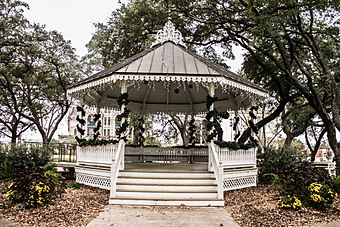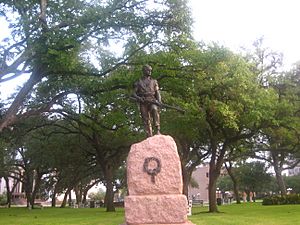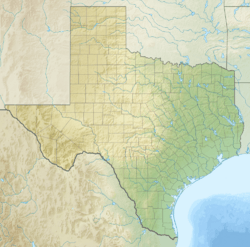DeLeon Plaza and Bandstand facts for kids
|
DeLeon Plaza and Bandstand
|
|

DeLeon Plaza and Bandstand in 2015
|
|
| Location | 100 blk. W. Constitution, Victoria, Texas |
|---|---|
| Area | less than one acre |
| Built | 1839 |
| Architect | Edward Linn, J.D. Mitchell |
| Architectural style | Bandstand |
| MPS | Victoria MRA |
| NRHP reference No. | 86002584 |
Quick facts for kids Significant dates |
|
| Added to NRHP | March 24, 1987 |
DeLeon Plaza and Bandstand is a historic park in Victoria, Texas. It covers almost two acres. This area was originally planned as the very center of the city. The bandstand, a special stage for music, was moved to the middle of the plaza in 1923. The plaza is known for its important monument called The Last Stand. This monument was created in 1912.
DeLeon Plaza and Bandstand was added to the National Register of Historic Places on March 24, 1987. This means it is a nationally recognized historic site. The bandstand itself was named a Recorded Texas Historic Landmark in 1965. The plaza also received this special Texas landmark status in 1998.
The Plaza's Beginning
When Victoria, Texas was first founded, it was named after Guadalupe Victoria. He was the first president of Mexico. The town was laid out by a surveyor named José María Jesús Carbajal. He designed the town around a central Market Square. This square was planned in 1839 by Edward Linn. Today, we know it as DeLeon Plaza. The bandstand, a place for musicians to play, was built before 1885.
The Last Stand Monument

A famous sculptor named Pompeo Coppini created a monument for the plaza. It is called The Last Stand, and sometimes Firing Line. A group called the William P. Rogers chapter of the United Daughters of the Confederacy paid $5,000 for it. This money was raised by the group. The monument was finished in 1912.
The unveiling of the monument was a big event on July 12, 1912. There was a parade and a free barbecue for everyone. Many important people attended the ceremony. It was also special because veterans from both sides of the American Civil War were there. Two veterans from the Union Army and twelve from the Confederate States Army attended.
Changes Over Time
In 1923, new "Memorial White Way" lights were turned on at DeLeon Plaza. In the same year, the bandstand was moved. It was placed in the center of the plaza. This spot used to be where the town's old water source was located.
The plaza's landscaping was updated in 1940. This was part of a project by the Works Progress Administration. This government program helped many people find work during a difficult time. Later, in 1962, Mr. and Mrs. J. M. Pickering helped restore the bandstand. Also in 1962, a Six Flags monument was placed on the plaza. It is at the corner of Main and Constitution streets.
Today, the plaza has twenty-three benches where people can sit. There are also forty-seven trees. These include live oak, elm, pecan, ash, magnolia, and redwood trees.
On December 31, 1986, a time capsule was buried in DeLeon Plaza. It is planned to be opened in 2036. That year will mark the 200th anniversary of Texas's independence.



